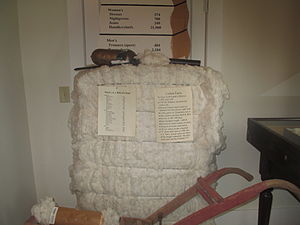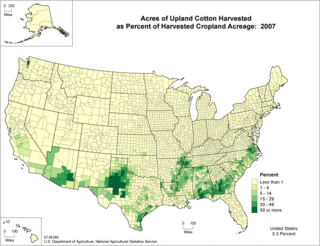
A cotton bale is a standard-sized and weighted pack of compressed cotton lint after ginning. The dimensions and weight may vary with different cotton-producing countries. [1]

A cotton bale is a standard-sized and weighted pack of compressed cotton lint after ginning. The dimensions and weight may vary with different cotton-producing countries. [1]
A bale has an essential role from the farm to the factory. The cotton yield is calculated in terms of the number of bales. [2] Bale is a standard packaging method for cotton to avoid various hassles in handling, packing, and transportation. The bales also protect the lint from foreign contamination and make them readily identifiable. [3]
Bale management encompasses the systematic procedures of categorizing, blending, and assessing bales based on fiber attributes, with the aim of achieving desired quality yarn production at an optimized cost. [4] Cotton fibres differ in terms of staple length and other physical characteristics; this is an inherent feature. [5] Bale management, also known as "bale mixing," is the process of analysing, classifying, and then blending fibres from various bales [which also includes the bales received from other stations] according to their fibre properties in order to create yarn of a specific quality at the most affordable price.[ citation needed ]
A "bale of cotton" is also the standard trading unit for cotton on the wholesale national and international markets. Although different cotton-growing countries have their bale standards, for example, In the United States, cotton is usually measured at approximately 0.48 cubic meters (17 cu ft) and weighs 226.8 kilograms (500 pounds). [6] In India, the standard bale size is 170 kg. [7] [8] [9] [10]
The most important parameters of a cotton bale are:
| Sr.No. | Country | Bale in kg |
|---|---|---|
| 1 | Australia | 227 |
| 2 | Colombia | 233 |
| 3 | Egypt | 327 |
| 4 | India | 170 [12] |
| 5 | Pakistan | 170 |
| 6 | Mexico | 230 |
| 7 | Nigeria | 185 |
| 8 | South Africa | 200 |
| 9 | Sudan | 191 |
| 10 | Tanzania | 181 |
| 11 | Uganda | 181 |
| 12 | United States of America | 225 |
Advances in standardization are reducing the variation in weights, sizes, dimensions, and densities of cotton bales. [7] [13]
Candy is another trading unit. A candy weighs approximately 2.09 bales (356 kg). [14] In India, ginned cotton is traded in terms of candy also which weighs 356 kg (355.62 kg). [15] [16] [10]
When cotton is harvested and exposed to ginning, it carries more than 64% cottonseed, 2% waste and 34% fibrous matter (also known as lint). [17] Lower trash percentage in cotton increases the recovery. [18] Cotton bales are not pure cotton; they contain foreign contaminants, residual trash and leaf (and other non lint material) that have a direct impact on the recovery in yarn spinning. [19] [20]

Cotton is a soft, fluffy staple fiber that grows in a boll, or protective case, around the seeds of the cotton plants of the genus Gossypium in the mallow family Malvaceae. The fiber is almost pure cellulose, and can contain minor percentages of waxes, fats, pectins, and water. Under natural conditions, the cotton bolls will increase the dispersal of the seeds.

Gossypium is a genus of flowering plants in the tribe Gossypieae of the mallow family, Malvaceae, from which cotton is harvested. It is native to tropical and subtropical regions of the Old and New Worlds. There are about 50 Gossypium species, making it the largest genus in the tribe Gossypieae, and new species continue to be discovered. The name of the genus is derived from the Arabic word goz, which refers to a soft substance.

A cotton gin—meaning "cotton engine"—is a machine that quickly and easily separates cotton fibers from their seeds, enabling much greater productivity than manual cotton separation. The separated seeds may be used to grow more cotton or to produce cottonseed oil.

Yarn is a long continuous length of interlocked fibres, used in sewing, crocheting, knitting, weaving, embroidery, ropemaking, and the production of textiles. Thread is a type of yarn intended for sewing by hand or machine. Modern manufactured sewing threads may be finished with wax or other lubricants to withstand the stresses involved in sewing. Embroidery threads are yarns specifically designed for needlework. Yarn can be made of a number of natural or synthetic materials, and comes in a variety of colors and thicknesses. Although yarn may be dyed different colours, most yarns are solid coloured with a uniform hue.
This timeline of clothing and textiles technology covers events relating to fiber and flexible woven material worn on the body. This includes the making, modification, usage, and knowledge of tools, machines, techniques, crafts, and manufacturing systems (technology).

Worsted is a high-quality type of wool yarn, the fabric made from this yarn, and a yarn weight category. The name derives from Worstead, a village in the English county of Norfolk. That village, together with North Walsham and Aylsham, formed a manufacturing centre for yarn and cloth in the 12th century, when pasture enclosure and liming rendered the East Anglian soil too rich for the older agrarian sheep breeds. In the same period, many weavers from the County of Flanders moved to Norfolk. "Worsted" yarns/fabrics are distinct from woollens : the former is considered stronger, finer, smoother, and harder than the latter.
A cotton picker is either a machine that harvests cotton, or a person who picks ripe cotton fibre from the plants. The machine is also referred to as a cotton harvester.

The textile industry is primarily concerned with the design, production and distribution of textiles: yarn, cloth and clothing.

Textile manufacturing or textile engineering is a major industry. It is largely based on the conversion of fibre into yarn, then yarn into fabric. These are then dyed or printed, fabricated into cloth which is then converted into useful goods such as clothing, household items, upholstery and various industrial products.

Textile fibers, threads, yarns and fabrics are measured in a multiplicity of units.
A staple fiber is a textile fiber of discrete length. The opposite is a filament fiber, which comes in continuous lengths. Staple length is a characteristic fiber length of a sample of staple fibers. It is an essential criterion in yarn spinning, and aids in cohesion and twisting. Compared to synthetic fibers, natural fibers tend to have different and shorter lengths. The quality of natural fibers like cotton is categorized into staple length such as short, medium, long staple, and extra-long. Gossypium barbadense, one of several cotton species, produces extra-long staple fibers. The staple fibers may be obtained from natural and synthetic sources. In the case of synthetics and blends, the filament yarns are cut to a predetermined length.

Arthur James Turner, CBE, FTI was a British scientist who worked in the field of textile technology. He was the first director of the Technological Laboratory created by the Indian Central Cotton Committee (ICCC) in Bombay in 1924. He was awarded the Warner Memorial Medal by the Textile Institute in 1931 in recognition of outstanding work in textile science and technology and was appointed to the CBE in 1950.

Uster Technologies, in its industry often called USTER, is a Swiss manufacturer of analytical instruments and on-line monitoring systems for the textile industry, based in Uster, Switzerland. It emerged as a management buy-out form of the textile division Zellweger Uster of the Zellweger Luwa Group in 2003. From 2007 until 2012 the company was publicly traded and listed on the main segment of SIX Swiss Exchange. Since 2012 Uster Technologies is a subsidiary of Toyota Industries.
Cotton classing is the measurement and classification of cotton by its specific physical attributes. This information is attached to individual bales, thus clarifying their value and helping producers market them. For cotton buyers, i.e. the spinning mills, this precise information about the cotton fiber enables them to achieve consistent yarn quality by optimizing raw material selection and blending.

A thread is a long strand of material, often composed of several filaments or fibres, used for joining, creating or decorating textiles. Ancient Egyptians were known for creating thread using plant fibers, wool and hair. Today, thread can also be made of many different materials including but not limited to cotton, wool, flax, nylon, silk, polyester etc. There are also metal threads, which can be made of fine wire.
Dimensional stability pertains to a fabric's ability to maintain its initial size and shape even after undergoing wear and care, which is a desirable property. Textile manufacturing is based on the conversion of fiber into yarn, yarn into fabric, includes spinning, weaving, or knitting, etc. The fabric passes through many inevitable changes and mechanical forces during this journey. When the products are immersed in water, the water acts as a relaxing medium, and all stresses and strains are relaxed and the fabric tries to come back to its original state.

The United States exports more cotton than any other country, though it ranks third in total production, behind China and India. Almost all of the cotton fiber growth and production occurs in the Southern United States and the Western United States, dominated by Texas, California, Arizona, Mississippi, Arkansas, and Louisiana. More than 99 percent of the cotton grown in the US is of the Upland variety, with the rest being American Pima. Cotton production is a $21 billion-per-year industry in the United States, employing over 125,000 people in total, as against growth of forty billion pounds a year from 77 million acres of land covering more than eighty countries. The final estimate of U.S. cotton production in 2012 was 17.31 million bales, with the corresponding figures for China and India being 35 million and 26.5 million bales, respectively. Cotton supports the global textile mills market and the global apparel manufacturing market that produces garments for wide use, which were valued at USD 748 billion and 786 billion, respectively, in 2016. Furthermore, cotton supports a USD 3 trillion global fashion industry, which includes clothes with unique designs from reputed brands, with global clothing exports valued at USD 1.3 trillion in 2016.
A blend is a mixture of two or more fibers. In yarn spinning, different compositions, lengths, diameters, or colors may be combined to create a blend. Blended textiles are fabrics or yarns produced with a combination of two or more types of different fibers, or yarns to obtain desired traits and aesthetics. Blending is possible at various stages of textile manufacturing. The term, blend, refers to spun fibers or a fabric composed of such fibers. There are several synonymous terms: a combination yarn is made up of two strands of different fibers twisted together to form a ply; a mixture or mixed cloth refers to blended cloths in which different types of yarns are used in warp and weft sides.
In textile spinning, yarn realisation (YR), or yarn recovery, is an operational parameter of yarn manufacturing. It is the percentage conversion of raw material to finished yarn. The rest of the waste fibers with less value are compared to the weight of the produced yarn from a given weight of raw material. The quantity of waste removed during the various phases of yarn spinning, such as blow-room, carding, and combing, is often used to determine yarn realisation. Yarn realisation ranges between 85% and 90% in carded cotton yarns and between 67% and 75% in combed cotton yarns.

Textile testing is the process of measuring the properties and performance of textile materials—textile testing includes physical and chemical testing of raw materials to finished products.
{{cite book}}: CS1 maint: others (link){{cite book}}: CS1 maint: others (link)